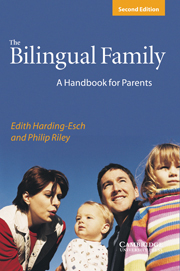Part III - An alphabetical reference guide
Published online by Cambridge University Press: 29 March 2010
Summary
Accent
Up to the time when both languages are completely separated, some bilingual children go through periods during which they speak one of their languages with a foreign accent. This usually happens when one of the languages develops more quickly than the other because of the circumstances, for example, the child hears much more German than English and so speaks English with a German accent. This should not be any cause for concern: provided your child continues to receive sufficient practice in both languages, she will acquire the ability to speak both without an accent. Mockery or humour at the expense of the child's accent, even when meant affectionately, should be avoided at all costs as it might make the child anxious and self-conscious.
Children who undergo successive bilingualism (see p. 69) before the age of twelve to fourteen usually acquire perfect accents in the second language to be learnt, provided that the bilingual environment is maintained. With very few exceptions, adults are unable to acquire perfect accents, even when their ability to speak the language is native-like in every other aspect.
Parents should beware of expecting ‘higher’ standards of pronunciation from their children than they expect of themselves. Above all, avoid puristic (and unrealistic) nit-picking of the ‘Did I hear you say often with a “t”?’ type or pouncing on intrusive ‘r’ s.
- Type
- Chapter
- Information
- The Bilingual FamilyA Handbook for Parents, pp. 135 - 177Publisher: Cambridge University PressPrint publication year: 2003



